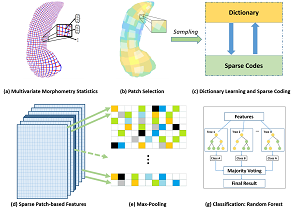Improved prediction of imminent progression to clinically significant memory decline using surface multivariate morphometry statistics and sparse coding
Cynthia M. Stonnington, Jianfeng Wu, Jie Zhang, Jie Shi, Robert J. Bauer III, Vivek Devadas, Yi Su, Dona E.C. Locke, Eric M. Reiman, Richard J. Caselli, Kewei Chen, Yalin Wang, and for the Alzheimer’s Disease Neuroimaging Initiative
Abstract
Besides their other roles, brain imaging and other biomarkers of Alzheimer’s disease (AD) have the potential to inform a cognitively unimpaired (CU) person’s likelihood of progression to mild cognitive impairment (MCI) and benefit subject selection when evaluating promising prevention therapies. We previously described that among baseline FDG-PET and MRI measures known to be preferentially affected in the preclinical and clinical stages of AD, hippocampal volume was the best predictor of incident MCI within 2 years (79% sensitivity/78% specificity), using standard automated MRI volumetric algorithmic programs, binary logistic regression and leave-one-out procedures. To improve the same prediction by using different hippocampal features and machine learning methods, cross-validated via two independent and prospective cohorts (Arizona and ADNI). Patch-based sparse coding algorithms were applied to hippocampal surface features of baseline TI-MRIs from 78 CU adults who subsequently progressed to amnestic MCI in approximately 2 years (“progessors”) and 80 matched adults who remained CU for at least 4 years (“nonprogressors”). Nonprogressors and progressors were matched for age, sex, education, and apolipoprotein E4 allele dose. We did not include amyloid or tau biomarkers in defining MCI. We achieved 92% prediction accuracy in the Arizona cohort, 92% prediction accuracy in the ADNI cohort, and 90% prediction accuracy when combining the two demographically distinct cohorts, as compared to 79% (Arizona) and 72% (ADNI) prediction using hippocampal volume. Surface multivariate morphometry and sparse coding, applied to individual MRIs, may accurately predict imminent progression to MCI even in the absence of other AD biomarkers.
Figures (click on each for a larger version):
Related Publications
- Zhang J*, Li Q*, Caselli RJ, Thompson PM, Ye J, Wang Y,, “Multi-Source Multi-Target Dictionary Learning for Prediction of Cognitive Decline”, In Information Processing In Medical Imaging (IPMI), 2017


